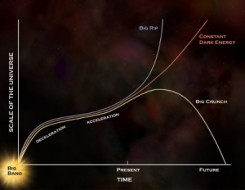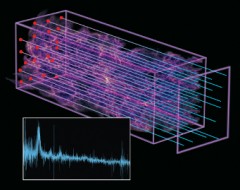The most precise measurement yet of the Hubble parameter illuminates dark energy — the elusive entity that’s accelerating the universe’s expansion.

Zosia Rostomian (Lawrence Berkeley National Laboratory) / Andreu Font-Ribera (Berkeley Lab)
Astronomers have used data from the Sloan Digital Sky Survey (SDSS) to precisely map the structure of the young universe. The most recent analysis, released on April 7th, pins down the expansion rate of the universe when it was only one-quarter of its present age.
"It's the most precise measurement of the Hubble parameter at any redshift (cosmic epoch), even better than the measurement we have from the local universe," says lead author Andreu Font-Ribera (University of Zurich, Switzerland, and Lawrence Berkeley National Laboratory)
SDSS utilizes millions of galaxies and thousands of quasars to illuminate the universe across multiple cosmic epochs, expanding our understanding of how the universe has evolved over its 13.8 billion years and shedding light on dark energy.
An Accelerating Universe
Since the Big Bang the universe has been expanding: the fabric of spacetime is stretching and carrying galaxies away from one another. But gravity — known for its ability to keep the Moon in orbit around Earth and bind together enormous clusters of galaxies — would certainly slow down the expansion as time went on. Or so we thought.
It came as a surprise when the data showed the opposite: the expansion is speeding up.
The best explanation for the universe’s surprising acceleration is some mysterious antigravity, a dark energy embedded in space itself.
The universe’s expansion rate depends directly on the density of energy in space. It may be characterized with the Hubble parameter, H, or the ratio of a faraway galaxy’s velocity to its distance. While a relatively simple concept, its units are slightly wacky at km/s per megaparsec (a parsec is 3.26 lightyears).

NASA / CXC / M.Weiss
Ever since the universe’s birth, both dark energy and gravity have been in a cosmic tug of war. For the first 8 billion years, gravity dominated, and cosmic expansion did slow down as expected. The universe was smaller and denser, making the Hubble parameter extremely large.
But as matter in the cosmos thinned out, gravity’s pull weakened and dark energy began to take over. The cosmic expansion stopped slowing and started accelerating. The Hubble parameter decreased rapidly. We’re in an era where the Hubble parameter is constant at approximately 73 km/s/Mpc.
Dark energy is a mind-boggling concept, but astronomers are pretty sure about it. Compelling evidence found in the cosmic microwave background and the clustering of galaxies also strongly support its existence.
Tracking Dark Energy Over Time
Now a project known as the Baryon Oscillation Spectroscopic Survey (BOSS), the largest component of the third Sloan Digital Sky Survey, is tracking dark energy over time. And it’s doing so with an amazing degree of precision.
A team led by Timothée Delubac (Centre de Saclay, France, and Federal Polytechnic Institute of Lausanne, Switzerland) has utilized and further constrained methods generated by Font-Ribera’s team to establish a Hubble parameter of 222 ± 6 km/s/Mpc at a redshift of 2.34, over 10 billion years ago.
This result shows that if the universe were less than a quarter of its present age, we would see that a pair of galaxies separated by 1 Mpc, or roughly 3 million light-years, would be moving away from each other at a rate of 222 km/s.
How can astronomers measure the Hubble parameter throughout cosmic time?
When the universe was young and extremely hot, overly dense spots of matter struggled between the inward pull of gravity and the outward push of radiation pressure from the photons in the plasma. This struggle sent waves rippling outward into space, somewhat like those created by a rock hitting water. The acoustic waves reverberated through the dense, hot plasma at speeds approaching the speed of light.
But once the universe cooled enough that atoms formed and photons could travel freely, the radiation pressure that was fueling the sound waves disappeared, causing them to leave slightly over-dense shells imprinted in the universe's matter. These ripple-like signatures — called baryon acoustic oscillations — continued to expand with the universe. Today their mark can be seen on the structure and spacing of the giant sheets and filaments of galaxies that later evolved.
The regular spacing between these structures creates a natural cosmic yardstick. By comparing the present-day size of these ripples (roughly 500 million light-years) with their size just after the universe cooled, we can learn how space has stretched over time.
But beyond a redshift of 0.7 (roughly 6 billion years ago), galaxies become fainter and more difficult to see. So Delubac’s team had to make use of the structure of distant intergalactic hydrogen gas to measure the baryon acoustic oscillations.

Zosia Rostomian (Lawrence Berkeley National Laboratory) / Nic Ross (Berkeley Lab) / Springel et al (Virgo Consortium and Max Planck Institute for Astrophysics)
The gas is impossible to see directly, but quasars — brilliant galactic centers fueled by supermassive black holes rapidly accreting material — illuminate the otherwise invisible matter. Any intervening clouds of hydrogen gas will leave dark lines in the quasar’s spectrum.
Detailed measurements of multiple quasars’ spectra close together can actually reveal the 3-dimensional nature of the intervening hydrogen clouds. From these maps, astronomers can extract the baryon acoustic oscillation signature.
"Three years ago BOSS used 14,000 quasars to demonstrate we could make the biggest 3-D maps of the universe," says David Schlegel (Lawrence Berkeley National Lab), principal investigator of BOSS. "Two years ago, with 48,000 quasars, we first detected baryon acoustic oscillations in these maps. Now, with more than 150,000 quasars, we've made extremely precise measures of baryon acoustic oscillations.”
By probing the Hubble parameter at such an early epoch, BOSS has measured a key anchor in the early universe when dark energy had yet to take hold. By comparing the parameter throughout cosmic history, astronomers will better determine the exact nature of the elusive energy that has mysteriously caused the expansion of our universe to speed up over the last 6 billion years.
References:
Andreu Font-Ribera et al. “Quasar-Lyman α Forest Cross-Correlation from BOSS DR11: Baryon Acoustic Oscillations” Journal of Cosmology and Astropartical Physics, 2014
Timothée Delubac et al. “Baryon Acoustic Oscillations in the Lyα forest of BOSS DR11 quasars” Astronomy & Astrophysics, 2014
 6
6









Comments
Sreedhar Rao-Sonti
April 12, 2014 at 1:15 am
Where does the space-time stretch into?
You must be logged in to post a comment.
Sreedhar Rao-Sonti
April 12, 2014 at 2:45 am
could it be that the AGN are quasars mimicking 'cosmic-lasers'
You must be logged in to post a comment.
Sreedhar Rao-Sonti
April 12, 2014 at 2:53 am
could it be that the AGN are quasars mimicking 'cosmic-lasers.'
You must be logged in to post a comment.
Peter Wilson
April 14, 2014 at 2:37 pm
Shannon: In the Friedmann equations--on which the standard model is based, and to which dark energy has been added--the universe was reduced to just two variables: density and expansion rate. A spherical cow, if you will. The universe was modeled as an ideal gas, as if stars, galaxies and galaxy clusters never happened. The assumption is that local contraction--star and galaxy formation--has exactly zero effect on cosmic expansion. Since the observed acceleration of the cosmic expansion was not predicted by the model, shouldn‘t this simplifying assumption be revisited?
You must be logged in to post a comment.
HDH
April 15, 2014 at 9:38 am
Couldn't the acceleration-deceleration-acceleration pattern simply suggest that the whole universe is ringing on a cosmic scale or that it fluctuates, just like any other dynamic system, with undulations larger than the observable universe (so as to be witnessed locally as accelerated cosmic expansion)?
You must be logged in to post a comment.
Peter Wilson
April 16, 2014 at 11:30 am
We won't know until local deceleration is taken into account. For example, it is well known that the Moon’s orbit is expanding, at a Hubble-like rate of about 100 km/s/Mpc. It is less well known that this expansion is accelerating, like the cosmos. It is not immediately obvious why. Yet when you include the relevant factors, voila, the math says the expansion of the Moon’s orbit must accelerate! Star and galaxy formation may or may not be causing the cosmic acceleration, but they should be included in the model. No? The simplified equations, sans star and galaxies, failed to predict the acceleration. Why not include their effect?
You must be logged in to post a comment.
You must be logged in to post a comment.